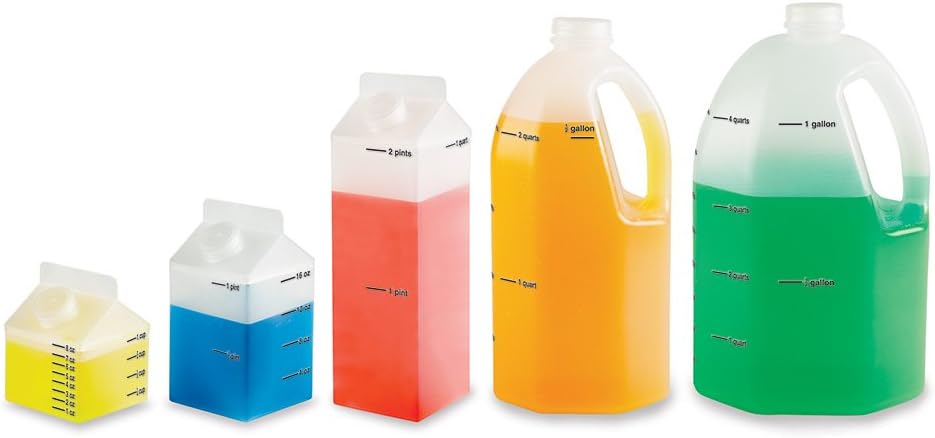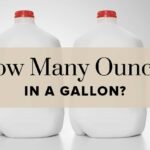Demystifying Liquid Measurement: Unveiling the Secrets of Quarts and Gallons
Have you ever stared at a recipe calling for buttermilk in quarts while your grocery bag held a lone gallon jug? Or perhaps you’re mixing a delicious fruit punch for a party and need to convert gallons to quarts for precise measurements. Fear not, for this comprehensive guide will untangle the complexities of liquid measurement and equip you with the knowledge to confidently navigate between quarts and gallons.
Understanding Units of Volume: Quarts vs. Gallons
Our journey begins by establishing a clear understanding of the fundamental units we’re dealing with: quarts and gallons. Both are used to measure volume, which refers to the three-dimensional space occupied by matter, in this case, liquids.
-
Quart (qt): A unit commonly used for measuring moderate volumes of liquids. There are two main types of quarts to consider:
- US Liquid Quart (US qt): The standard quart used in the United States, it holds 4 liquid cups or 32 fluid ounces (fl oz). This is the type of quart referred to in most recipes and household measurements.
- Imperial Quart (imp qt): Used in the United Kingdom and some Commonwealth countries, it’s slightly larger than a US quart (about 40 fluid ounces).
-
Gallon (gal): A larger unit typically used for measuring substantial volumes of liquids. Similar to quarts, there are two primary types of gallons:
- US Liquid Gallon (US gal): The standard gallon used in the United States, it holds 4 quarts or 128 fluid ounces (fl oz). This is the type of gallon referred to in most recipes, household measurements, and at gas stations.
- Imperial Gallon (imp gal): Used in the United Kingdom and some Commonwealth countries, it’s slightly larger than a US gallon (about 160 fluid ounces).
Important Note: Throughout this article, we’ll focus on US liquid quarts (US qt) and US liquid gallons (US gal) unless otherwise specified.
The Conversion Formula: A Simple Key to Unlocking the Mystery
Now that we’ve identified the players, let’s unveil the formula for converting between quarts and gallons. The beauty lies in its simplicity:
Number of Gallons (US gal) = Number of Quarts (US qt) / 4
This formula essentially divides the total number of quarts by 4, which is the number of quarts in a US liquid gallon.
Conversion Examples: Putting the Formula into Action
Let’s solidify our understanding with some practical examples:
-
Converting Quarts to Gallons:
- You have a recipe that requires 8 quarts of vegetable broth, but you only have a gallon jug (4 quarts) on hand. Is there enough broth?
- Apply the formula: Number of Gallons (US gal) = 8 quarts / 4 quarts/gal = 2 gal
- Therefore, you have enough broth, as 2 gallons is more than the recipe’s requirement of 8 quarts (a little less than 2 gallons).
- You have a recipe that requires 8 quarts of vegetable broth, but you only have a gallon jug (4 quarts) on hand. Is there enough broth?
-
Converting Gallons to Quarts:
- You’re making a large batch of iced tea that requires 2 gallons of water. How many quarts of water do you need?
- Since there are 4 quarts in a gallon, you simply multiply the number of gallons by 4: 2 gallons * 4 quarts/gallon = 8 quarts
- You’ll need 8 quarts of water for the iced tea recipe.
- You’re making a large batch of iced tea that requires 2 gallons of water. How many quarts of water do you need?
Beyond the Basics: Additional Considerations
While the core conversion formula is straightforward, a few additional points deserve mention:
-
Rounding: In real-world scenarios, you might encounter measurements that don’t translate perfectly into whole numbers. It’s generally acceptable to round to the nearest appropriate unit depending on the application. For example, if a recipe calls for 3.25 quarts of broth, you can likely use 3 quarts without significantly impacting the outcome.
-
Density: The conversion formula assumes we’re dealing with liquids with a density close to water. For significantly denser or lighter liquids, slight variations might occur. However, for most common household applications, the standard conversion will suffice.
-
International Considerations: As mentioned earlier, the US uses the US liquid quart (32 fl oz). If you’re working with recipes or measurements from other countries, you might encounter imperial quarts (40 fl oz). Double-check the type of quart being used to ensure accurate conversions.
Applications of Converting Between Quarts and Gallons
Understanding the relationship between quarts and gallons comes in handy in various situations:
- Cooking and Baking: Recipes often specify ingredients in cups or quarts, while larger quantities might be listed in gallons. Knowing how to convert between these units allows .
-
Mixing Beverages: Party planning often involves large quantities of beverages. Converting between gallons and quarts helps you determine how much of each ingredient you need to create the perfect amount of punch, lemonade, or mixed drinks.
-
Buying in Bulk: When purchasing liquids like milk, juice, or cleaning solutions in bulk, understanding quart and gallon conversions allows you to compare prices and determine the most cost-effective option for your needs.
-
Gardening and Home Maintenance: Fertilizers, weed killers, and cleaning solutions for larger areas might be sold in gallons. Converting to quarts helps you measure the correct amount for your specific application.
-
Understanding Gas Mileage: While gas pumps in the US typically dispense gasoline in gallons, some older vehicles might have fuel efficiency ratings listed in miles per quart. Converting between gallons and quarts allows you to estimate your car’s gas mileage more accurately.
Beyond Conversion: Tips for Mastering Liquid Measurement
-
Invest in a good quality measuring set: Having a set of measuring cups with clear markings in both cups and quarts, along with measuring spoons for smaller quantities, can significantly improve your measurement accuracy in the kitchen and beyond.
-
Label your containers: If you frequently store liquids in containers other than their original packaging, consider labeling them with the volume they hold in quarts or gallons. This saves time and prevents confusion.
-
Practice makes perfect: The more you convert between quarts and gallons, the more comfortable you’ll become with the process. Don’t hesitate to experiment with practice conversions to solidify your understanding.
By understanding the relationship between quarts and gallons, along with the valuable tips provided, you’ll be well-equipped to tackle any liquid measurement challenge with confidence. No more staring at a gallon jug wondering how many quarts it holds! Now, get out there and experiment with your newfound knowledge in the kitchen, garden, or wherever your liquid measuring needs may take you!
Frequently Asked Questions (FAQ) About Quarts and Gallons
1. How many cups are in a quart?
There are 4 cups in a US liquid quart (US qt). It’s important to note that cups can refer to dry cups (used for dry ingredients) or fluid cups (used for liquids). This article focuses on fluid cups, which are equivalent to 8 fluid ounces (fl oz).
1. How many pints are in a quart?
There are 2 pints in a US liquid quart (US qt).
2. How many ounces are in a quart?
There are 32 fluid ounces (fl oz) in a US liquid quart (US qt).
3. What if I don’t have a measuring cup with quart markings?
No worries! You can improvise using readily available household items. Here’s a quick conversion guide:
- 1 cup = 2 cups (US qt)
- 1 liter = approximately 1.06 quarts (US qt)
4. Are there online conversion tools available?
Absolutely! There are numerous online conversion calculators that can handle unit conversions between quarts, gallons, cups, liters, and other volume units. These tools can be handy for quick conversions without memorizing formulas.
By understanding the relationship between quarts and gallons and the various applications of this knowledge, you’ve unlocked a valuable skill for navigating the world of liquid measurements. So, the next time a recipe calls for buttermilk in quarts, or you’re planning a party that requires precise beverage measurements, you’ll be ready to tackle the task with confidence!



